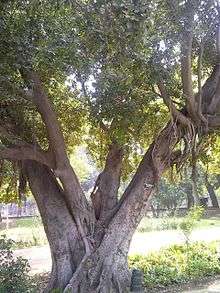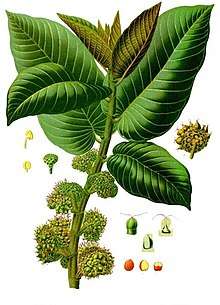Moraceae
The Moraceae — often called the mulberry family or fig family — are a family of flowering plants comprising about 38 genera and over 1100 species.[2] Most are widespread in tropical and subtropical regions, less so in temperate climates; however, their distribution is cosmopolitan overall. The only synapomorphy within the Moraceae is presence of laticifers and milky sap in all parenchymatous tissues, but generally useful field characters include two carpels sometimes with one reduced, compound inconspicuous flowers, and compound fruits.[3] The family includes well-known plants such as the fig, banyan, breadfruit, mulberry, and Osage orange. The 'flowers' of Moraceae are often pseudanthia (reduced inflorescences).

| Moraceae | |
|---|---|
 | |
| Panama rubber tree (Castilla elastica) | |
| Scientific classification | |
| Kingdom: | Plantae |
| Clade: | Tracheophytes |
| Clade: | Angiosperms |
| Clade: | Eudicots |
| Clade: | Rosids |
| Order: | Rosales |
| Family: | Moraceae Gaudich.[1] |
| Genera | |
|
See text | |
Historical taxonomy
Formerly included within the now defunct order Urticales, recent molecular studies have resulted in the family's placement within the Rosales in a clade called the urticalean rosids that also includes Ulmaceae, Celtidaceae, Cannabaceae, and Urticaceae. Cecropia, which has variously been placed in the Moraceae, Urticaceae, or their own family, Cecropiaceae, is now included in the Urticaceae.[4]
Dioecy (having individuals with separate sexes) appears to be the primitive state in Moraceae.[5] Monoecy has evolved independently at least four times within the family.
Characteristics
Flowers
The flowers are often small, with single whorled or absent perianth. Most flowers have either petals or sepals, but not both, known as monochlamydeae, and have pistils and stamens in different flowers, known as diclinous. Except for Brosimum gaudichaudii and Castilla elastica, the perianth in all species of the Moraceae contain sepals. If the flower has an inflexed stamen, then pollen is released and distributed by wind dispersal; however, if the stamen is straight, then insect pollination is most likely to occur. Insect pollination occurs in Antiaropsis, Artocarpus, Castilla, Dorstenia, Ficus, and Mesogyne[6]
Leaves
The leaves are much like the flowers when analyzing diversity. The leaves can be singly attached to the stem or alternating, they may be lobed or unlobed, and can be evergreen or deciduous depending on the species in question.[7] The red mulberry can host numerous leaf types on the same tree. Leaves can be both lobed and unlobed and appear very different, but coexist on the same plant.[8]
Fruits and seeds
Plant species in the Moraceae are best known for their fruits. Overall, most species produced a fleshy fruit containing seeds. Examples include the breadfruit from Artocarpus altillis, the mulberry from Morus rubra, and the jackfruit from Artocarpus heterophyllus.[5][9]
Distribution
Moraceae can be found throughout the world with a cosmopolitan distribution, thought to be due to the breakup of Gondwana during the Jurassic period.[10] The majority of species originate in the Old World tropics, particularly in Asia and the Pacific islands[11]
Phylogeny
Modern molecular phylogenetics suggest these relationships:[4][5][9][12]
| ||||||||||||||||||||||||||||||||||||||||||||||||||||||||||||||||||||||||||||||||||||||||||||||||||||||||||||||||||||||||||||||||||||||||||||||||||||||||||||||||||||||||||||||||||||||||||||||||||||||||||
Tribes and genera
The Moraceae comprise:[13]
- Artocarpeae Lam. & DC. 1806
- Artocarpus J.R.Forst. & G.Forst. (~50 spp.)
- Batocarpus H.Karst. (4 spp.)
- Clarisia Ruiz & Pav. (3 spp.)
- Hullettia King ex Hook.f. (2 spp.)
- Parartocarpus Baill. (3 spp.)
- Prainea King ex Hook.f. (4 spp.)
- Treculia Decne. ex Trécul (3 spp.)
- Castilleae C.C.Berg 1977
- Antiaropsineae (C.C.Berg) Clement & Weiblen 2005
- Antiaropsis K.Schum. (1 sp.)
- Sparattosyce Bur. (1 sp.)
- Castillineae Clement & Weiblen 2009
- Antiaris Lesch. (1 sp.)
- Castilla Cerv. (3 spp.)
- Helicostylis Trécul (7 spp.)
- Maquira Aubl. (5 spp.)
- Mesogyne Engl. (1 sp.)
- Naucleopsis Miq. (~20 spp.)
- Perebea Aubl. (9 spp.)
- Poulsenia Eggers (1 sp.)
- Pseudolmedia Trécul (~9 spp.)
- Antiaropsineae (C.C.Berg) Clement & Weiblen 2005
- Dorstenieae Dumort. 1830
- Bleekrodea Blume (3 spp.)
- Bosqueiopsis De Wild. & T.Durand (1 sp.)
- Brosimum Sw. (13 spp.)
- Broussonetia L’Hér. ex Vent. (8 spp.)
- Dorstenia L. (~105 spp.)
- Fatoua Gaudich. (3 spp.)
- Helianthostylis Baill. (2 spp.)
- Malaisia Blanco 1837 (1 sp.)
- Scyphosyce Baill. (2 spp.)
- Sloetia Teijsm. & Binn. ex Kurz 1864 (1 sp.)
- Trilepisium Thouars (1 sp.)
- Trymatococcus Poepp. & Endl. (2 spp.)
- Utsetela Pellegr. (1 sp.)
- Ficeae Gaudich. 1830
- Ficus L. (750 spp.)
- Maclureae W.L. Clement & Weiblen 2009
- Maclura Nutt. (11 spp.)
- Moreae Dumort. 1829
- Fossils
- †Artocarpoides
References
- Angiosperm Phylogeny Group (2009). "An update of the Angiosperm Phylogeny Group classification for the orders and families of flowering plants: APG III" (PDF). Botanical Journal of the Linnean Society. 161 (2): 105–121. doi:10.1111/j.1095-8339.2009.00996.x. Retrieved 2013-07-06.
- Christenhusz, M. J. M.; Byng, J. W. (2016). "The number of known plants species in the world and its annual increase". Phytotaxa. 261 (3): 201–217. doi:10.11646/phytotaxa.261.3.1.
- Judd WS, Campbell CS, Kellogg EA, Stevens PF, Donoghue MJ (2008). Plant Systematics: A Phylogenetic Approach. Sunderland, MA: Sinauer Associates, Inc. pp. 1–620. ISBN 978-0-878-93407-2.
- Sytsma KJ, Morawetz J, Pires C, Nepokroeff M, Conti E, Zjhra M, Hall JC, Chase MW (2002). "Urticalean rosids: Circumscription, rosid ancestry, and phylogenetics based on rbcL, trnL–F, and ndhF sequences" (PDF). American Journal of Botany. 89 (9): 1531–1546. doi:10.3732/ajb.89.9.1531. PMID 21665755.
- Datwyler SL, Weiblen G (2004). "On the origin of the fig: Phylogenetic relationships of Moraceae from ndhF sequences". American Journal of Botany. 91 (5): 767–777. doi:10.3732/ajb.91.5.767. PMID 21653431.
- Leite VG, Mansano VF, Teixeira SP (2018). "Floral Development of Moraceae species with emphasis on the perianth and androecium". Flora. 240 (Flora): 116–132. doi:10.1016/j.flora.2018.01.009.
- Khyade VB. (2016). "Mulberry Family (Moraceae) - FLowers, Fruits and Leaves". Science J Rank.
- TWC Staff (2018). "Morus rubra (Red Mulberry)". Wildflower.org.
- Clement WL, Weiblen GD (2009). "Morphological evolution in the mulberry family (Moraceae)". Systematic Botany. 34 (3): 530–552. doi:10.1600/036364409789271155.
- "Gondwana". Encyclopedia Britannica.
- Zerega NJC, Clement WL, Datwyler SL, Weiblen GD." (2005). "Biogeography and Divergence times in the mulberry family (Moraceae)". Molecular Phylogenetics and Evolution. 37 (2): 402–416. CiteSeerX 10.1.1.418.1442. doi:10.1016/j.ympev.2005.07.004. PMID 16112884.CS1 maint: multiple names: authors list (link)
- Zerega NJ, Clement WL, Datwyler SL, Weiblen GD (2005). "Biogeography and divergence times in the mulberry family (Moraceae)". Molecular Phylogenetics and Evolution. 37 (2): 402–416. CiteSeerX 10.1.1.418.1442. doi:10.1016/j.ympev.2005.07.004. PMID 16112884.
- Hepworth C. (2018). "Moraceae - The Mulberry Family". Florida Fruit Geek.CS1 maint: uses authors parameter (link)
External links
| Wikispecies has information related to Moraceae |
| Wikimedia Commons has media related to Moraceae. |